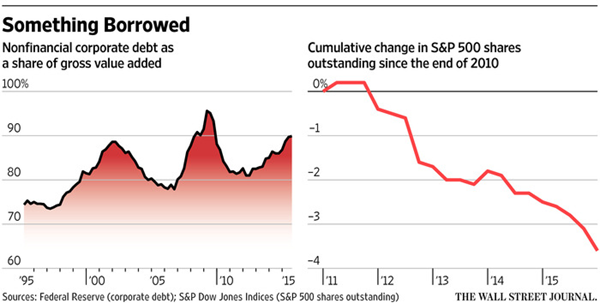|
THE
WALL STREET JOURNAL.
Markets |
Heard on the
Street
Share Buybacks: The Bill Is Coming Due
U.S. companies borrowed heavily in recent years but often bought
back stock rather than investing in their business
|

Traders at the New York Stock Exchange Friday PHOTO: BRENDAN
MCDERMID/REUTERS |
By
Justin
Lahart
Feb. 28, 2016 1:46 p.m. ET
Low rates alone aren’t
enough to make it easy to pay off a loan. Many companies may find that
out the hard way, especially as high-yield debt markets show signs of
strain lately.
U.S. companies went on a
borrowing binge in recent years. Nonfinancial corporations owed $8
trillion in debt in last year’s third quarter, according to the
Federal Reserve, up from $6.6 trillion three years earlier. As a share
of gross value added—a proxy for companies’ combined output—corporate
debt is approaching levels hit in the financial crisis’s aftermath.
Most of the debt
increase came from bond issuance, as nonfinancial companies took
advantage of the
lowest rates on corporate bonds
since the mid-1960s. That is a plus as companies in many cases
extended the maturity of their debt and lowered borrowing costs.
The negative: Rather
than investing the funds they raised back into their businesses,
companies in many cases
bought back stock instead. That
was something that many investors welcomed, but it may have come with
future costs that they didn’t fully appreciate.
In aggregate,
nonfinancial companies’ cash flows over the past three years were
enough to cover capital spending. That is unusual—typically, capital
spending outstrips cash flows as companies invest for growth—and is
reflective of
how muted business investment has
been since the financial crisis. Over the same period, the companies
repurchased $1.3 trillion in shares.
Because those stock
buybacks helped reduce companies’ total shares outstanding, earnings
per share got a boost. Indeed, absent the past three years’
share-count reductions, S&P 500 earnings per share would have been 2%
lower in the fourth quarter than what companies are reporting,
according to S&P Dow Jones Indices.
The major reason
companies plowed money into buybacks rather than capital spending was
that, in a low-growth environment, the returns from investing in
expansion didn’t seem as attractive as in the past. This is a big part
of why companies were able to borrow cheaply: In a low-growth,
low-inflation environment, investors were willing to accept lower
returns on corporate bonds than if the economy was moving at a more
rapid clip.
The sticking point is
that in a low-growth environment, paying down debt also may be harder.
Especially because companies weren’t putting the money they borrowed
into capital investments, which provide cash flows to help service
debt. The stock they bought back won’t do that for them.
Even if this doesn’t
present an immediate problem for all companies given how they
refinanced debt to longer maturities, it could be a long-term drag on
earnings.
Of course, if necessary,
companies could issue new equity to help meet debt payments. But
existing investors would get diluted.
In many cases, companies
have large cash reserves they could tap. This, too, has drawbacks. One
is that, in cases where the cash is overseas, it might be subject to
taxation before it could be used. Another is that companies’ cash
holdings are reflected in their shares. If their cash is diminished,
so is their share price.
Investors who cheered as
companies bought stock with borrowed money could end up blanching when
they see the bill.
Write
to
Justin Lahart at
justin.lahart@wsj.com
|

